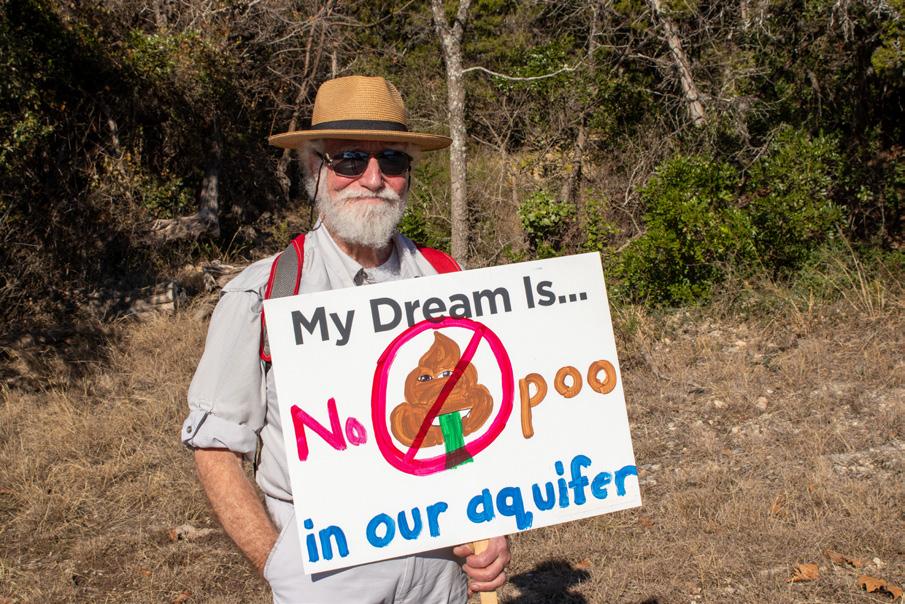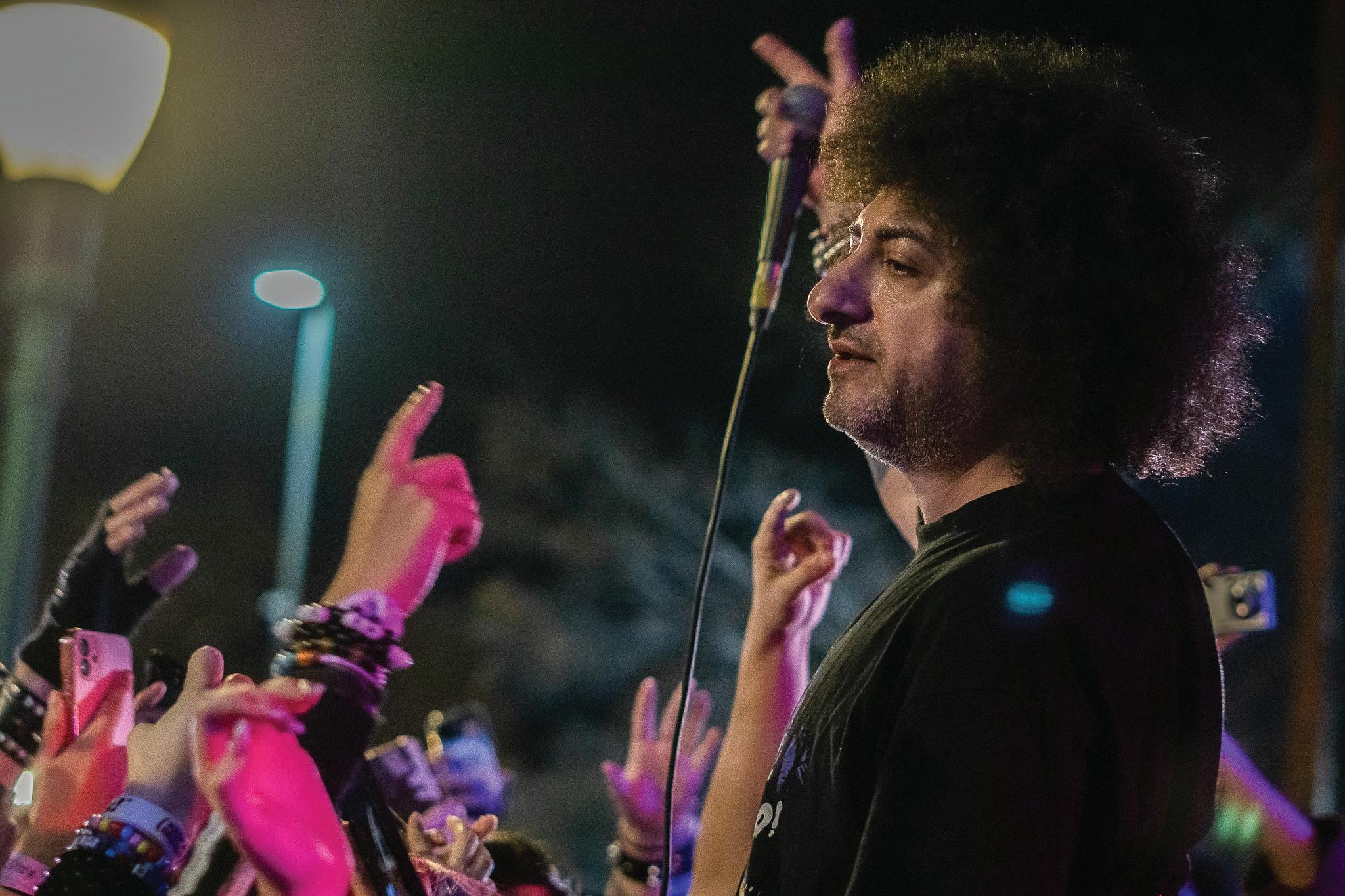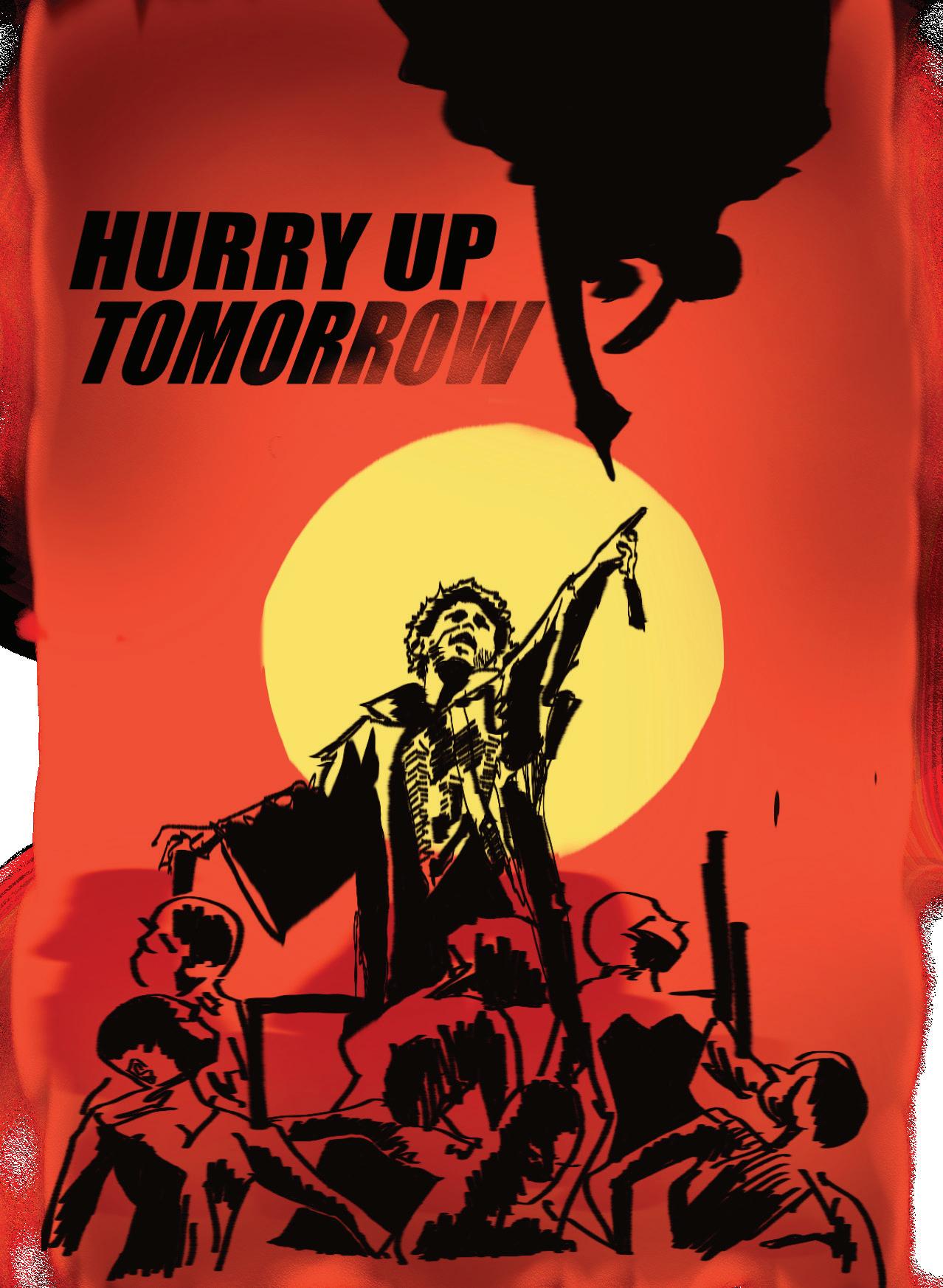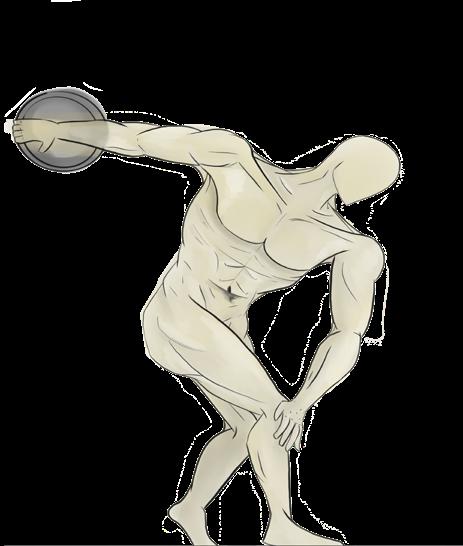








City leaders in Grey Forest hosted the “Million Gallon March” to raise awareness about water quality concerns linked to the proposed Guajolote Ranch development in far Northwest Bexar County. The proposed Lennar Subdivision wastewater treatment plant would discharge an estimated 1 million gallons of treated wastewater into Helotes Creek each day.
In November, the Texas Commission on Environmental Quality ruled that the City of Grey Forest has the right to challenge the wastewater permit. A hearing is scheduled for February, after which TCEQ will decide whether to move forward with the plant. Homeowners near the proposed
private wells for their drinking water. The primary concern is that the treated wastewater could contaminate these wells, potentially endangering their water supply.
The “Million Gallon March” took place on Sunday, Feb. 2, from 2 p.m. to 4 p.m. at The View at Helotes Creek.
San Antonio Mayor Ron Nirenberg emphasized the importance of addressing the issue, stating, “Pollution is something everyone should care about. But the first and most important thing we must recognize is that this isn’t a Democrat issue, a Republican issue, or an environment-versuseconomy issue. This is about the future of the entire Central Texas region. Our water supply is the engine of the Texas economy, and threatening that future would jeopardize all of us.” than 200 people attended the rally and marched in support of challenging the wastewater permit. The event aimed to show solidarity ahead of the contested case hearing before TCEQ.

Paul Garrow, Mayor of Grey Forest, addressed the crowd, saying, “There is a proposed dense development just a few miles away from here, at Guajolote Ranch. The density of that development raises
concerns about traffic, pollution, and most importantly, the potential harm to our water system. Between Feb. 18 and 21, the City of Grey Forest, local property owners and the Greater Edwards Aquifer Alliance will testify before TCEQ, which will decide whether to grant the permit. We’re hopeful that the hearing officer will reject it.”
Stressing the importance of blocking the permit, Garrow continued, “If we can stop this permit, we can encourage more responsible development and help protect our homes and water supply.”
Garrow also highlighted the significance of the region’s aquifers. “We are standing on a very sensitive part of our water system, including the Trinity, Glen Rose and Edwards aquifers. Pollution could severely impact these critical water sources. We’re here to raise awareness about the threat to our water supply. In March, we’ll be carrying water jugs to symbolize the one million gallons of wastewater that could be discharged into our aquifers,” Garrow said.
Helotes Mayor Rich Whitehead also spoke out against the proposed wastewater discharge. “The development will build a treatment plant that takes in sewage, treats it and discharges the treated water. The plan is to release one million gallons of treated wastewater into Helotes Creek every day,” Whitehead explained. Wastewater is mostly water with a few
other elements thrown into it. These elements may be small but can create a danger to the public’s health.
This wastewater discharge would not only affect homeowners and landowners but also have a potentially harmful impact on local wildlife, plants and pets. Whitehead added, “Even if everything works as planned, and the water is treated properly, there are still concerns about contaminants, smells and debris affecting properties. The wastewater will flow through Grey Forest and Helotes, potentially leaving residue and silt behind. If the treatment process isn’t done correctly, it could lead to significant contamination.”
For UTSA students looking to get involved, Nirenberg encourages them to organize and raise awareness. “You are a significant part of the population in this region, and your collective voice can make a real difference. People often underestimate the influence that students can have on political decisions. Organize, educate others and help people understand that this issue directly threatens the vitality of the San Antonio region and your access to clean drinking water,” Nirenberg vocalized.

By Marisela Cruz Staff Writer
In preparation for a new Institute of Texan Cultures museum, UTSA was given permission to destroy the Texas Pavilion despite the San Antonio Conservation Society’s strong objections to demolishing the 1968 historical site. Corrina Green, Chief Real Estate Officer at UTSA, requested the raze of the Texas Pavilion. The Texas Historical Commission approved UTSA’s request to demolish the pavilion to further redevelop the HemisFair Historic District. The Texas Conservation Society has a petition with over 2,000 signatures seeking to preserve and reuse the significant landmark. A remediation has been in process for the past couple of weeks delaying the demolition.
The demolition is set to happen during the summer. Joe Izbrand had no comment
to give to The Paisano on the subject of the raze and relocation of the Institute of Texan Cultures. Executive Director of the San Antonio Conservation Society Vincent Michael said the SCS is “against UTSA, the city and the historical society granting permission for demolition.”
“[I hope] the city moves forward judicially and not irrationally,” Michael said.
The plan to tear down the Texas Pavilion is in preparation for San Antonio’s “Project Marvel,” which includes plans for a new professional basketball arena to be built on the property.
The idea for the new sports arena surfaced in February 2023, when the University of Texas System Board of Regents conditionally approved a plan to lease or sell the property to the city. UTSA plans to sell the 13 and one-half
acre property to fund the new museum, which is estimated to be located behind the Crockett Hotel on an existing parking lot.
The Texas Historical Commission’s “go-ahead and the university’s timeline” of the approval and expected demolition did not sit well with the Conservation Society of San Antonio.
Conservation Society President Lewis Vetter said in a December article by San Antonio Express-News that he criticizes the “rushed decision.”
UTSA pitched to the state commission that it would cost $74 million to maintain it, therefore leveraging their reason to demolish one of the last buildings from the HemisFair World’s Fair for educational purposes.
UTSA plans to honor the Texas Pavilion in the new location of the ITC.
This is a two-part article. The next issue will reflect on the history of the Folklife Festival that was part of the Institute of Texans Cultures.

By Daria Tanase Staff Writer
On May 3, San Antonio’s biennial mayoral election will be held. San Antonio’s current mayor, Ron Nirenberg, has been in office since 2017 and has reached the maximum amount of terms he can serve.
Candidate filings began on Jan. 15 and will end on Feb. 14. The candidates who have officially filed to run for mayor for San Antonio are posted on the San Antonio Government Website. The mayoral candidate list consists of Santos Alvarado, Arturo Espinosa, Adriana Rocha Garcia, Christopher Herring, Gina Ortiz Jones, James “Jae” Melvin, Robert Melvin, Christopher Reyes, Mauricio Sanchez, Sonia Eliza Traut, Andrew Fernandez Vicencio and Tim Westley and Beto Altamirano.
Current residents in Bexar County that are registered to vote can participate in this upcoming election. To check the status of a resident’s ability to vote, visit the Bexar County’s Voter Check Registration Website. The last day to register is Thursday, Apr. 3.

Bexar County residents can either request an application for ballot by mail or can locate early voting and election day polling locations via the Bexar County Elections Department Website. Early voting takes place from Apr. 22-29 and on May 3, election day, the polls are open from 7 a.m. to 7 p.m.
By Maria Wence Staff Writer
On President Donald Trump’s first official day in office for his second term, he signed off various executive orders relating to immigration, mass deportations and border control.
The rise of immigration raids in America are intended to target immigrants who carry a criminal background first, including undocumented individuals who have any minor offenses ,such as a driving violations.. The U.S. Immigration and Customs Enforcement plans to begin raids in major cities, such as Chicago, Boston, Washington D.C., Miami, Los Angeles, Denver, New York and San Antonio.
Trump has started his efforts to decrease illegal immigration from Mexico by attempting to reinstate the “Wait in Mexico” policy, which was active during his previous administration in 2019. The policy requires immigrants who seek asylum at the southern border to wait within Mexican border cities until their official hearings in U.S. immigration court.
To bolster the policy, the Trump administration is sending 1,500 troops, including helicopter crews and intelligence analysts, to the southern border. This would be a 60% increase in active duty military personnel.
In addition to the increase in security,Trump seeks to conduct military airlifts to deport more than 5,000 people detained by the U.S. Customs and Border Protection — beginning in San Diego, California and El Paso, Texas.

By Jasmine Williams Managing Editor
Additionally, ICE will no longer be avoiding “sensitive” areas — including elementary schools, secondary schools, colleges, hospitals and churches — when raids begin, as the Trump administration believes many illegal immigrants hide in these spaces. A DHS spokesperson said the new policy gives ICE and CBP the ability “to enforce our immigration laws and catch criminal aliens, including murderers and rapists who have illegally come into our country.”
In response to these new changes, the National Immigration Law Center has released statements reminding individuals of their rights regardless of their immigration status, namely the legal protections provided by the Fourth and Fifth Amendment. 80 educational and other organizations sent letters on Jan. 20 to state and local leaders to urge them to reject antiimmigrant activity.
A anonymous student at UTSA has recently earned their dual citizenship; however, they have immigrant parents and family members. They shared their thoughts and emotions about the recent immigration raids.
“This whole situation brings me back to my childhood, when my parents got deported and knowing other families are going through the same thing makes me sad. It was like my whole world was crumbling.
“My family has been through this all of our lives, the constant hatred against our race, and I couldn’t say they feel different now as they are still going through it,” the student said. “This whole situation will break so many friendships and relationships and the atmosphere is gonna be really intense. I feel like a lot of hatred will come into play as well.”
In a final comment, the UTSA student remarked, “You’re in danger of losing a loved one or you’re basically losing your dreams and it’s a sad reality.”
In compliance with the Clery Act, UTSA keeps a daily crime log for all on-campus crimes. The log summarizes the case’s date, time, location, incident and current status. The crimes detailed below are taken directly from the crime log, showcasing the trends premiered from Jan. 25 to Feb. 1.
Minor in possession of alcohol
On Jan. 25, an incident of a minor in possession of alcohol at Chaparral Village occurred from 11:21 p.m. to 12:03 a.m. Two other offenses that occurred were possession of a controlled substance and possession of less than two ounces of marijuana. The case remains active
Larceny/theft
On Jan. 27 at 10:30 p.m., larceny/theft was reported to UTSAPD. The offense occurred from Jan. 6 at 8:32 a.m. to Jan. 17 at 2 p.m. at
Alvarez Residence Hall. The value of the stolen property amounted to less than $100. The case remains active.
Graffiti
On Jan. 29, a graffiti offense took place from 3:06 p.m. to 3:20 p.m. The offense occurred at the Student Union Building. The disposition of the case was not stated.
Duty on striking an unattended vehicle
On Jan. 30, two offenses of duty on striking an unattended vehicle were reported to UTSAPD. The first incident occurred at Resident Lot 5 while the second occurred at East Campus Lots. Both cases remain active.
Driving under the influence of alcohol by a minor
On Jan. 31, between 1:33 a.m. and 2:03 a.m. at Brackenridge Ave. Lot 2, a driving while under the influence of alcohol by a minor offense occurred. The incident was cleared by arrest.

By Christopher Delgado Staff Writer
Low senator occupancy, amendments, chairs and finances were among the topics discussed at the Student Government Association’s eighth session of the 49th general assembly. The session commenced at 5:30 p.m. with a presentation from Chief Financial Officer and Vice President for Financial Affairs Sheri Hardison. Hardison discussed the 2024 fiscal year, which ended in August, and UTSA’s budget. According to the data, the net capital assets for the 2024 fiscal year equaled $907,000,000 with the total endowment equaling $315,000,000. This is an increase from the 2023 net capital assets of $882,000,000 and total endowment of $287,000,000. Following Hardison’s presentation, Study Abroad Director Mean Avellana presented study abroad opportunities for students attending UTSA. The SGA then moved into voting procedures. Voting commenced on the induction of Sahana Baba as the Business Affairs Chair. Baba was elected unanimously in a voice vote by SGA senators. Senators and attendees spoke on Baba’s collaboration skills and charisma as reasons to vote in Baba’s favor. The reasons stopped here.
The chair of internal affairs was also voted on. Sarah Esther Sarabia received a nomination by Speaker Madeline Snyder and was elected unanimously in a voice vote by SGA senators. “We all see how empty the senator chairs are. We need senators,” SGA President Aydan Villarreal remarked preceding the vote for Sarabia.
Chief Elections Commissioner Michaela Mgba opened the next voting procedure by offering a recommendation to amend the procedures of elections and SGA body for the 50th General Assembly of the Student Government Association at UTSA. The proposed amendments included moving Senate seat elections to the fall and increasing the number of elected officers from three to five.

By Alejandra Garza Staff Writer
Not subscribed to local news but still want to stay up-to-date on the happenings around town? Look no further. Highlighting notable stories from external San Antonio news sources, State of the City summarizes the most captivating news headlines of the week. This week’s topic ranges from pitbull attack to students protesting Trump’s political agenda.
Pitbull attack hospitalizes man
On Tuesday, Nov. 28 deputies responded to a 911 call on the 8400 block of Shooter Cove where a man was severely injured by a pit bull. The 43-year-old unidentified victim sustained multiple injuries to his lips, chin and cheek. It was reported by the Sheriff’s office the attack started when the man and his wife were walking their dog and the pit bull attacked their pet. Intervening between the two dogs; the pitbull turned on him causing him to be dragged to the ground. The owner of the pitbull was later identified as 39-year-old Veronica Elizabeth Polley. Neighbors told deputies another attack had occurred in 2023 regarding the same pitbull owned by Polley. She is now facing charges including Attack by a Dog Resulting in Serious Bodily Injury.
San Antonio students protest
A peaceful protest of Trump’s recent executive orders has been planned for Feb. 5 and will consist of a walkout at around 12:25 pm, where students and community members will meet. After gathering as many supporters as possible, the peaceful protest will head to city hall at 3 p.m. The protest was organized by San Antonio Independent School District students and grassroots coalition Mujeres Marcharan. Organizers cited multiple issues — such as the end of birthright citizenship, banning all gender affirming care for people under 19-years-old and defunding research surrounding gender affirming care. A call to action social media post was shared by Mujeres Marcharn showing their frustration with the Trump administration’s decision. “This is more than just a protest against Trump — It’s a stand for justice, for humanity, and for the future we deserve,” the post reads. “We should not just sit back while our future is being shaped by leaders who do not represent us. We are the future and we should never be silenced.”
Newborn baby in critical condition after being abandoned
In the early morning of Jan. 21 an off-duty San Antonio police officer is stunned by a discovery of an abandoned baby boy barely breathing with the umbilical cord still attached. The baby was in critical condition and suffered a severe amount of blood loss. Doctors also tested the baby’s blood to find traces of methamphetamine. According to an arrest warrant, a man claimed he was lost and could not find a hospital when he approached the officer for help. It was later revealed the man knew the identity of the mother and where she had given birth. This led investigators to 28-year-old Ava Marie Guerra who had given birth to the baby boy in a friend’s toilet bowl. Guerra was charged with injury to a child and reckless serious bodily injury. Records show she has posted a $150,000 bond, but is still in the process of being released.
President Donald Trump recently called for a freeze on federal spending for loans and grants in a memo issued on Jan. 27 by the Office of Management and Budget. This proposed freeze has alarmed states, schools and organizations that depend on the trillions in funding from Washington, D.C. The freeze could have serious consequences for universities, nonprofits and other groups reliant on federal financial support.
Fortunately, two federal judges blocked the freeze at the end of January. Following this decision, the administration issued a brief two-sentence notice rescinding the original memo on Jan. 29, adding to the confusion surrounding the situation. After the memo was rescinded, a second federal judge issued a block that has since been extended.
The administration clarified that the freeze would not impact federal assistance to individuals — such as Social Security, Medicare, food stamps, student loans or scholarships. Officials stated that the pause was “necessary” to review whether spending aligns with Trump’s executive orders on issues, like climate change and diversity, equity and inclusion programs.
“The Executive Orders issued by the President on funding reviews remain in full force and effect and will be

rigorously implemented by all agencies and departments,” White House Press Secretary Karoline Leavitt stated, placing the blame for the confusion on the courts and news outlets. “This action should effectively end the court case and allow the government to focus on enforcing the President’s orders on controlling federal spending.”
Despite the order being slimmed down, it could have grave implications for millions of Americans who rely on federal assistance. This is a harsh measure that could disproportionately harm vulnerable populations,
Commentary
By Luna Infante Staff Writer
In the now-divided U.S., abrupt change is either welcomed with open arms or rejected. On Jan. 20, Donald Trump issued an executive order concerning immigration. The official order reads, “Enforcing our Nation’s immigration laws is critically important to the national security and public safety of the United States.” Since then, the U.S. Immigration and Customs Enforcement has arrested thousands of undocumented immigrants, according to NBC.
On Jan. 27, Mexican-American actress Selena Gomez posted a video on her Instagram story, seemingly reacting to the deportations. She was visibly distressed. Talking through tears, she wrote “I’m sorry” with a Mexican flag emoji over the video. Gomez cried, “I just want to say I’m so sorry. All my people are getting attacked. The children, they don’t understand. I’m so sorry.”
Within hours, the video was deleted, followed by a story, “Apparently it’s not ok to show empathy for people.” However, Gomez very clearly mishandled her feelings regarding this situation.
To write a serious post or share sympathy in a video is one thing, to cry and apologize aimlessly is another. As a public figure with a large platform, addressing profound issues in a mature manner is important for raising awareness or making change. However, recording herself sobbing about something that does not directly impact her comes off as tone-deaf and manipulative. Her video was unhelpful and appeared to be a reach for attention.
In response to Gomez’s video, the
White House released a video on their official X account featuring the mothers of victims of violence perpetrated by immigrants. The women shared how it is hard to believe Gomez’s reaction and that she does not know who she is crying for. One woman shared how she felt the video was a ruse to garner sympathy. While these women have every right to mourn the death of their children, the White House’s video is a direct attack on Gomez, which is unprofessional and unfair. Gomez sharing sympathy for immigrant children and families does not mean she does not see the other side of the coin.
This situation is not black and white, and the arguments about immigration are certainly not. The mass deportations are terrifying for many innocent, undocumented families, and the deportation of dangerous immigrants is relieving to many — these are not mutually exclusive. However, one thing should remain clear, Gomez’s attempt to the mark

particularly seniors. The Older Americans Act Nutrition Program, which supports community-based initiatives like Meals on Wheels, could face funding cuts as a result. The freeze could also disrupt funding for the National LowIncome Housing Coalition. There are growing concerns that programs under the Department of Housing and Urban Development might also be impacted by the freeze. The legal implications of the freeze remain uncertain. If implemented, it would affect millions of Americans, whether individually or through their businesses. Despite the federal judges’blocks on the order, nonprofits throughout the nation are reporting a lack of funding, forcing layoff.
This order may even be deemed unconstitutional. The Impoundment Control Act of 1974 clearly prohibits presidents from temporarily or permanently withholding enacted funding, and it sets forth procedures for how the president can propose delaying or rescinding funds. Presidents do not have the authority to selectively ignore parts of laws or determine how much funding that has been signed into law reaches the American people. This reckless act by the president is baffling in its execution and harmful to the country’s most vulnerable.
Commentary By Sofia Mejia Magazine Editor
On Jan. 13, Starbucks reversed its open door policy, which allowed people to stay in the shop without making a purchase. This decision is one of many in recent times that demonstrates how companies can comfortably and openly detest the homeless.
In 2018, Starbucks announced the open door policy after an incident involving two Black men who were arrested for sitting in a Starbucks without having made a purchase. This caused an outcry on the internet and led to multiple protests against Starbucks. At the time, Starbucks CEO Jonathan Gardner pledged that the company would “[do] whatever we can to make things right” and “let [customers] know of our plans to investigate the pertinent facts and make any necessary changes to our practices that would help prevent such an occurrence from ever happening again.”
feels safe enough to reverse this decision with the weak excuse that “ setting clear expectations for behavior and use of our spaces” will “create a better environment for everyone.”
Their decision will mostly impact the homeless. Starbucks is one of the largest chains in America with over 1,700 locations. This makes it an easily recognizable and previously accessible spot for the homeless looking for shelter and bathrooms. Starbucks’s claim that the change is to create a better environment insinuates that the homeless and unpaying are a nuisance. The homeless are the most vulnerable in our society, and empathy is needed for those going through the hardest times. Companies like Starbucks choose to make life worse for the impoverished because they feel they will not face negative consequences from the public. It is important to show class solidarity and remember the chances of being homeless are far greater than the chance of having the wealth of a multi-billion dollar need to — once again — protest Starbucks and push them to change this policy. Until then, it is time for customers to buy their coffee

Commentary
By Mogbekeleoluwa Shebioba Staff Writer
Created in the 1940s and popularized by the Marvel Cinematic Universe , actor Chris Evans’ Captain America — also known as Steve Rogers — is one of the most popular Marvel superheroes today. Wielding his signature shield and sporting a red, white and blue suit, the “America” in his title speaks for itself. The character was created to represent ideals that American citizens should have, not necessarily what they already had. Captain America was intended to be a symbol of peace, especially since his comic debuted in the middle of World War II.
After Rogers retired, the Captain America mantle was passed on to Sam Wilson, who was formerly known as Falcon, the second Black superhero. The MCU adapted this, so Anthony Mackie, the actor who portrays Sam Wilson, now carries the super soldier’s former title.
When Mackie was asked what Captain
America represents to him, he responded, “Captain America represents a lot of different things, and I don’t think the term ‘America’ should be one of those representations. It’s about a man who keeps his word, who has honor, dignity and integrity.”
Anthony Mackie is correct and shows a proper understanding of the character.
Captain America represents the American dream, which a lot of Americans struggle to grasp in the first place. He believes in the ideas of what the U.S. claims it stands for — not the hundreds of years of discrimination and bigotry that plague its history. Despite this, Mackie’s statement started quite the discussion on social media, specifically, X. X is notorious for having an obscene

amount of nazi and racist content posted by users of the platform ever since Elon Musk — the man who threw out a Nazi salute at the president’s inauguration — purchased it in 2022. Therefore, it is no surprise that Mackie, being a black man, garnered controversy on the website for his statement. Some people responded claiming Sam Wilson is Falcon and will never be Captain America. This is a tired argument people have been making for years when it comes to Black heroes taking over the mantle of white superheroes.
Most notably, Miles Morales as Spider-Man.
It is even more telling when Evans, a white man, said the same thing about Captain America, yet he received no
backlash. This is a fairly self-explanatory situation.
To emphasize Mackie’s point even further, in Amazing Spider-Man issue #537, Captain America says, “Doesn’t matter what the press says, doesn’t matter what the politicians or the mobs say, doesn’t matter if the whole country decides that something wrong is something right. This nation was founded on one principle above all else: the requirement that we stand up for what we believe, no matter the odds or the consequences. When the mob and the press and the whole world tell you to move, your job is to plant yourself like a tree beside the river of truth, and tell the whole world, ‘No, you move’.”
Despite what his name might bring to mind, Captain America is not some propaganda-spewing mouthpiece. He does not represent what America is; he represents what America should be. So if America chooses to become Captain America’s enemy, they should expect he will fight like he always has.
Commentary
By Selaise Gifa-Johnson
Contributor
Since the end of World War I, the U.S. has made numerous attempts to purchase Greenland, an autonomous territory of Denmark. Being an autonomous territory means it is part of the Kingdom of Denmark. It falls under Danish sovereignty for foreign policy and defense while retaining the ability to selfgovern. Despite the offers made in the past, Denmark has always turned down U.S. proposals to buy Greenland while preserving the diplomatic relationship between the two countries.
This trend continued when President Donald Trump expressed his desire to purchase Greenland in January. However, the recent stern denial from Danish President Mette Fredricksen has not deterred Trump’s fixation. Trump’s unwavering desire to forcefully acquire territory from a fellow North Atlantic Treaty Organization (NATO) country is an egregious overreach of U.S. influence in the region.
NATO is a collective security agreement in which all members pledge to protect each other in the event of a military attack from a non-member nation. Article 5 of the treaty specifically states an attack on one member is an attack on all members, which raises the question of what happens when one member levies a threat against another member. While this may seem like an exaggeration, Trump has explicitly
stated that he “thinks we’re going to have [Greenland],” calling it an “absolute necessity” and even stating that “the people want to be with us,” which is simply untrue.
Contrary to Trump’s claims, only 6% of Greenland citizens want to join the U.S. Trump has not made any definitive statements about which method he intends to use to acquire Greenland, but he has not ruled out economic and military force, which shows Trump’s disregard for the spirit of NATO.
During Trump’s unabated crusade, he continually mentions national and world security as the primary reasons the U.S. should own Greenland. Yet, these claims are baseless. The region of the Atlantic ocean between Greenland and Europe has been an important region for NATO security since the beginning of the Cold War, with NATO countries even conducting a joint military exercise called “Strikeback” in September of 1957 to practice defending the region. Operations like Strikeback are prime examples of methods Trump could use to enhance the security of the North Atlantic while diplomatically maintaining and strengthening international relationships.

The much more likely motivation for Trump wanting to acquire Greenland could be the wealth of untapped natural resources being revealed by the melting glaciers on the island. Metals — like lithium, copper and cobalt, which are vital to the development of clean energy technologies — are being discovered in high quantities as climate change melts the ice that once concealed them.
Editorial Board
Jake Mireles | Editor-in-Chief Editor@paisano-online.com
Jasmine Williams | Managing Editor Manager@paisano-online.com
Alessandra Avila | News Editor News@paisano-online.com
Marcela Montufar Soria | Opinion Editor Opinion@paisano-online.com
Malaki Lingg | Arts & Life Editor Arts@paisano-online.com
Haley Aguayo | Sports Editor Sports@paisano-online.com
Raul Martinez | Web Editor Web@paisano-online.com
Armin Suljovic | Photo Editor Photo@paisano-online.com
Kara Lee | Graphic Editor Graphic@paisano-online.com
Regan Williams | Multimedia Editor Multimedia@paisano-online.com
Sofia Mejia | Magazine Editor Magazine@paisano-online.com Jaclyn Banda |
Trump’s security concerns further lose validity because U.S. security risks in that region originate from fears of the
WHO will save us now?
Commentary By Khoi Nguyen Staff Writer
President Donald Trump’s decision to withdraw the U.S. from the World Health Organization (WHO) last week is a dangerous and tone-deaf move that highlights growing divide over education and recalls his former strife with credible health experts.
Amidst the growing bird flu threat, he has unwittingly maimed the U.S. of indispensable medical resources, citing the Biden administration’s “mishandling of the COVID-19 pandemic” — the same pandemic in which Trump, as president, denounced vaccines. The Trump administration also cited “onerous payments” to WHO, yet failed to mention those payments have contributed to WHO’s pivotal breakthroughs with smallpox, HIV and tuberculosis. Further, doctors working for WHO will lose their jobs, and many will be stripped of accessible medical care.
While withdrawing from WHO threatens research and health overseas, U.S. citizens’ relationship with healthcare is in a precarious spot. Misinformation will further proliferate as the bridge between the U.S. and several credible leaders in health — if not burns — slackens. Americans
The most concerning aspect of Trump’s uncompromising stance toward Denmark and Greenland is the message it sends to other NATO countries. Trump’s recent overreach of American influence in the North Atlantic risks shaking confidence in NATO. His sentiment alone is enough to make European countries reconsider the value of NATO and potentially seek alternative alliances to protect themselves

who previously ignored the cries of 750 experts in law, medicine and academia. What is even more terrifying is that many of us continue to listen to him.
Trump’s deeply controversial first weeks in office bring to mind the failings of America’s thinking and ultimate decision in the last election. Groceries will not become any cheaper by entering a tariff war, healthcare will not improve by withdrawing from the organization that eradicated smallpox and DEI is not relevant to a tragic plane crash.
Trump’s supporters frequently boast “Make America Great Again,” yet the actions of America’s new figurehead outright contradict greatness and leadership.
Making America great again does not start with erroneously withdrawing funding to an organization devoted to health or denying people access to life-saving medical resources. While Americans may be stuck with Trump for the next four years, they will come to realize the consequences of his administration will far surpass its time.
Commentary
By Jaylee Paredes Contributor
President Donald Trump recently signed an executive order aimed at fighting antiSemitism by revoking the visas of international students who participate in Pro-Palestine protests. These protests were meant to educate others peacefully and not engage in any kind of anti-semitism.
This caused a lot of controversy because it is a clear infringement of the constitution. The first amendment protects people’s right to protest, and deporting non-citizens who showed their support by protesting and sharing their political beliefs is unconstitutional.
There is a fact sheet on this matter which stated how officials will take “forceful
and unprecedented steps to combat anti-semitism.” Every federal executive department and agency leader has 60 days
come 2025, we will find you, and we will deport you,” the fact sheet said. By trying to silence students

to review and report all civil authorities for fighting antisemitism.
“To all the resident aliens who joined in the pro-jihadist protests, we put you on notice:
on this matter, the government incites unnecessary fear and discourages lawful political discourse and protests. Protesting and expressing political beliefs are not a
foreign concepts in the U.S.; in fact, it is one of the best ways to build change. There have been many protests, such as the marches for George Floyd and the march in Washington for LGBTQ+ rights. None of the people who participated in these were threatened with deportation.
The Pro-Palestine protests are no different from any other protests in the past, and the people participating should not be threatened with deportation.
The U.S. is a democracy, and protesting is well within everyone’s rights. These kinds of policies are very dangerous and undermine the principles of the constitution. It is imperative to protect the freedom of speech for everyone, regardless of their citizenship status.

By Malaki Lingg Arts & Life Editor Reviews
As time goes on, old trends tend to repeat themselves. A decade ago, the nineties were having their renaissance, and more recently, the Y2K aesthetic has made an overwhelming resurgence into pop culture. Riding on the success of Y2K’s comeback is the re-emergence of emo music — think of acts like My Chemical Romance, Sunny Day Real Estate and Hawthorne Heights.
This past Saturday, San Antonio emo fans flocked to the Plaza Guadalupe for the first ever A Very Emo Valentine’s Music Fest. The stacked bill featured headlining act Hawthorne Heights, supported by legendary acts Saosin and I Set My Friends On Fire, along with smaller, local acts such as Medusa Complex and Sleep Schedule.
With 21 performances, the day was long, but San Antonio was unafraid — filling the venue to the brim. Each artist had their own draw, bringing in fans of local acts and small touring artists, simultaneously introducing emo fans to a whole new world of fifth-wave emo music.
Likely the most hyped performance of the night, Saosin took the stage at 7:45 p.m. Their commanding presence entranced the audience; for many, they had seen the band here in the countdown city 10 years ago, but for the younger crowd, it was their first time seeing these legends. With the excitement of finally being able to see the emo powerhouse, the energy swelled from the crowd and surged over the barricade. While crowd surfers were redirected back into the crowd, the band deflected that energy right back into the masses.
When hit track “Seven Years” rang through the venue, the crowd grew still yet restless. Everyone laid in wait for the cue “The story ends,” before the powerful screams commanding “I would find a way without” tore through the stage monitors into the crowd’s heart.
Saosin led a more than memorable experience — claiming “We’re up here like a bunch of sigmas,” while trying to relate to their younger audience.
Following Saosin is I Set My Friends On Fire, an aggressive and comedic emo band from Miami, fronted by Matt Mehana.
The band would go on to have the most exciting performance of the night, pushing the crowd to engage more and join the on-stage antics. In breaks between songs, Mehana would talk about how he was “really hungry for brisket,” leading to one attendee giving him their tater tots, while another yelled, “Go get some f—cking puffy tacos dude.”
Mehana and the band really knew how to wow a crowd, with a two-minute period of concertgoers throwing wristbands and rave candy at the band. Following this, he was pushed to but eventually refused to try on a pair of plastic shutter shades, exclaiming “I can’t wear these, I look too much like the guy from LMFAO.”

With an exhilarating performance from such a goofy group, how could anyone live up to I Set My Friends On Fire’s performance? Luckily, the last band was not just anyone, with Hawthorne Heights taking the stage immediately after Mehana’s group. The group had a massive 80-minute block to perform in.
Hawthorne Heights did more than live up to what came before, giving a legendary performance for the 210.
Opening their performance, lead vocalist J.T Woodruff expressed his gratitude for San Antonio.
“San Antonio was one of the first real cities [to] discover emo music. San Antonio has just been a little more sad than other places. Thank you for being like us, and letting us play,” said Woodruff. “After all these years, let’s stay f—cking sad.”
While not the most energetic band to grace a stage this night, they still take first place for the most memorable performance.
With their catchy melodic riffs and hopeful yet depressing lyrics about their dead-end Ohio hometown, they brought the audience in close, leaving them with something they would never forget.
In between songs, Woodruff would share words of wisdom about the need to travel, battles with mental illness and discovering yourself when you do not know where you belong — all of which are prevalent themes in the band’s music.
Closing the night, the band opted not to do an encore, citing that they are going to act like a band from the 70s and just announce that they are playing their last song, also because they do not want to be awkward and wait side-stage.
Of course, their final song was “Ohio Is For Lovers,” a song they never thought would be as popular as it is. With multiple phenomenal performances from the emo community, the first ever — and hopefully annual — A Very Emo Valentines Music Fest is an overwhelming success. Though, there were some issues with management and at times a lack of security — hopefully the next festival will be even better.

By Khoi Nguyen Staff Writer
Lions draped in red, silver and gold danced with such uncanny grace it was hard to think underneath were two separate heads and bodies. Martial artists moved in junction with their swords and staves, engaged in a brutal, yet beautiful geometry. Festival-goers in cosplay walked about — a Pikachu, a group of maids, a Withered Bonnie.
On Feb. 1-2, the San Antonio Asian New Year Festival was held in Rolling Oaks Mall, kicking off Lunar New Year with a diverse showcase of Asian and Pacific Islander culture. With its four stages and an endless list of performers, festival-goers could witness Japanese sumo wrestling, K-pop drag shows, cosplay contests and hula dancing. Stands snaked through the mall’s corridors, boasting trinkets from ornate chopsticks and beaded necklaces to enamel Hello Kitty pins and Pokémon figurines. Outside, food trucks sold candied fruit skewers known as tanghulu, lobster balls and teriyaki kebabs. The festival’s contents, spanning continents and centuries, reflect its mission to welcome all.
“We want to showcase everybody, so they can come out here and share their culture,” Renée Park, founder and organizer of the festival, said. “If we can get a little taste to everybody here, it’s great.”
While the festival’s wide array of activities make it a big event, its beginnings were humble, evolving



throughout the years: a simple potluck between friends, a neighborhood gathering, a community celebration at the San Antonio Museum of Art growing so large it had to be pushed to the Institute of Texan Cultures

— which it eventually outgrew. Today, SAANYF is a weekend-long festival attracting 20,000 visitors, the
height of a gradual metamorphosis that aptly parallels the festival’s record of Asian history as it evolves.
“My children have grown up with [this festival] and now my grandchildren. It’s generations. We see it. I see it in my vendors,” Park said. “One young lady asked me, ‘Hey, Auntie Renée, you remember me?’ I [was] like, ‘No.’ That was fifteen years ago, and now she brings her little girl.”
While the festival celebrates heritage, for many — especially performers — it is also a reunion. Dojos, K-pop dance groups, cosplaying performers and even a lion dancing association come onto the same stage, grateful to celebrate the coming year together. Beyond being an opportunity for communities to share their cultures, the festival is also an important fundraiser for many of them.
“A lot of them are nonprofits — churches and schools. They were very excited [to come back]. We want to share all of this and be thankful for everything that’s happened.” Lunar New Year itself is rooted in gratitude. Red is worn as a symbol of good fortune, and offerings are made to honor ancestors while embracing the possibilities of the future. The festival reflects this spirit, bringing together different generations and traditions under one roof.
“I think the most [important] thing is and what’s also beautiful about this is, many of our cultures here have history,” Park said. “Not everyone got along, but for everybody to still come here and share is amazing. You’re learning more and more.”
By Alois White Contributor
SPOILER WARNING: “Companion,” written and directed by Drew Hancock, delivers an ever-so-relevant commentary on artificial intelligence, misogyny and the complexity of abusive relationships.
Released on Jan. 31, the film follows Iris, played by Sophie Thatcher, living in a bizarre existence as a companion robot to Josh, played by Jack Quaid. The couple travels to a remote mansion to meet with Josh’s friends, but their getaway quickly swerves off course.
At the encouragement of one of the other guests, the host tries to take advantage of Iris, resulting in her killing him. This catalyst pushes Iris closer towards realizing her place in Josh’s life: an object to be controlled. The film draws a clear connection between the way Josh treats Iris and the prevalence of misogyny and control over women in society.
The audience learns with Iris the extent of Josh’s control. His decision to set her intelligence low and her inability to control the car unless mimicking his voice conveys the little autonomy she holds. Thatcher’s performance captures Iris’s descent and the transition of her imitative, artificial speech into genuine horror. Similarly, Josh’s progression from a seemingly socially awkward guy into someone almost unrecognizable was an impressive feat. In the latter half of the film, his fall into a power-hungry craze

Caroline Puckett/The Paisano

becomes evident as he forces Iris to hold her hand into a flame. He does this not only because he is upset but because he can — a jarring contrast to the meetcute at the beginning of the movie.
The film offers more nuance than expected. Programmed or not, the love Iris feels for Josh is real, and it makes it harder for her to come to terms with Josh’s malicious intentions. Despite knowledge of his wrongdoing, she still retains her reminded of the memories she holds with Josh and the man he used to be. For as long as she has existed, her world revolved around him. To break from his control is to face the reality that those good memories are tainted with his power and outright lies. This detail creates a realistic depiction of an abusive relationship.
Additionally, Eli and his robot boyfriend Patrick have a complex relationship in which love and artificial intelligence is explored. The film attempts to navigate the complicated nature of their love: The conflicting control Eli will always have over Patrick and Patrick’s knowledge of this. Ultimately though, these concepts were not fully realized to the extent they could have been.
A captivating dark comedy thriller, “Companion” is certainly worth a watch and serves as a strong start to a new year of movies.




By Rylan Renteria Staff Writer
“Rasquachismo,” was first coined by Dr. Tomás Ybarra-Frausto in 1989 for an exhibit organized by a Chicano artist group in Phoenix, Arizona. The term was created in an attempt to reclaim the word “rasquache,” which is slang for low-class and often used to discredit the cultural creativity and uniqueness found within Chicano culture.
“Rasquachismo: 35 years of Chicano sensibility,” is a display that is being hosted at the McNay Art Museum from Dec. 19 to Mar. 30. This exhibit features Mexican-American artists showcasing their talents while incorporating familiar items or styles that hold value within their culture and meaning from their lives.
Upon entering the exhibit, visitors are greeted by sculptures constructed with various materials. The most notable of the bunch is “Mi Chicano Corazón (ca. 2023),” by Einar and Jamex de la Torre –two siblings who have been collaborating since the early 1990s. The sculpture features a sleek glass design of a human heart with cactus branches extending upwards and the cactus’ vibrant green roots embedded back into the heart. The piece represents the deeply rooted love for Chicano culture that both artists share.
A common theme amongst pieces in the exhibit is the use of beer logos. In Diana Molina’s piece, “Luz de la Luna (Moonbeam) (ca. 2017),” the artist combines wrappers of a color pattern
By Christopher Delgado Staff Writer
In the year 2000, Professor Drinka and students within the linguistics department created a time capsule for words and dialects they predicted would become part of the U.S. jargon in 2025. On Jan. 25, professors, alumni, students and the local community gathered to unearth said linguistics department time capsule.
In attendance were Helen Petry Stowe, class of Dec. 1999, and Rebecca Blankenship, class of 2000.
When asked about some of the guesses they may have made 25 years ago, Blankenship responded, “I have no idea. Hopefully, nothing embarrassing.”
The capsule was divided into four subsections of linguistics: slang, word formation, sound changes and semantic shifts. Amongst some of the predictions made were the use of the term “a clint” in lieu of a lie, a functional shift for “emote” from a verb to a noun
and a division between the electronically literate and illiterate with the latter becoming the underclass. Many were influenced by the onslaught of technology, the phenomenon known as Y2K, Bush v. Gore and President Clinton’s affair — note the creation of “a clint.”
Not all of the predictions were a success but some proved prophetic. One student in 2000 predicted the slang creation of “cell-watch” to describe a watch that is also a phone or computer.
Shifts in sound changes were also highlighted. One attendee prophesied mumbling being at the forefront of dialect due to the popularization of mumble rap, while another user hypothesized an uptick in Kermit the Frog voice as a means of immortalizing “The Muppets.”
While the 2000 time capsule brought participants together, the real attraction of the night was to create the 2025 linguistics time capsule that will be opened in 2050. Attendees received mini-lessons
By Armin Suljovic
Photo Editor
Abel Tesfaye, better known as The Weeknd, is retiring his famous moniker with “Hurry Up Tomorrow,” the third and final chapter of his 2020s trilogy composed of “After Hours” and “Dawn FM.” Released on Jan. 31, this 22-track album serves as the cinematic farewell to the persona that has defined his career to date.
The album opens with “Wake Me Up,” immediately setting the introspective theme across the album, sounding like an interpolation of Michael Jackson’s “Thriller” in its ominous build-up and tonal shifts. The Weeknd delivers an emotional performance as he questions his struggles with fame and self-doubt.
Lyrically, “Hurry Up Tomorrow” is deeply reflective. The Weeknd grapples with existential questions, pondering

his mortality and his personal demons. Songs like “Reflections Laughing” and “Baptized in Fear,” express his struggles with identity and fame, while “Give Me Mercy” and “Drive” focus on religious redemption and acceptance.
Sonically, the album explores a wide range of styles over its 84-minute runtime. “Given Up On Me” starts with a smooth trap beat swiftly transforming into a classical piano ballad. “São Paulo” is directly inspired by Brazilian funk. “I Can’t Wait to Get There” channels an oldschool R&B sound, adding a nostalgic touch. Meanwhile, synth-heavy tracks like “Open Hearts” showcase the versatility The Weeknd has to offer.
In this trilogy, “After Hours” embodied self-destruction and sin, followed by the purgatorial state explored in “Dawn
FM.” The title track, “Hurry Up Tomorrow,” symbolizes the end of The Weeknd persona, as he bids farewell to the character with an emotional plea for freedom from his past pain. This final track marks the turning point, allowing The Weeknd to emerge as someone new. Despite the album’s towering tracklist of 22 songs, the quality remains cohesive throughout. The songs’ smooth transitions, innovative production and mature lyricism make “Hurry Up Tomorrow” a fitting conclusion to both The Weeknd’s trilogy and the character. It is a farewell message encapsulating who The Weeknd has become while hinting at what the rebirth of Abel Tesfaye may entail.
that presents a tapestry-esque look. The blend of aluminum wrappers from brands — such as Dos Equis, Dove Chocolate and Cashew Roca — creates a shiny effect mimicking a luxurious gold texture while yielding a similar pattern to a zarape, a traditional Mexican cloak-like clothing article. This collage represents the elegance found in items that can be found in lower-class communities.
On the far right of the exhibit lies “Under the Mexican Colchas (ca. 2012)” by American-born artist Ruth Buentello. The San Antonio native describes her work as “examining gender, culture and place to capture narratives of Brown subjects and their relationships within domestic spaces.” The acrylic painting portrays an older Mexican couple lying on a bed together. The male character sports a cowboy hat without a shirt, and the female character lies on her back in a vibrant yellow striped shirt. The male sits upright with a tired expression on his face; the female has no mouth. Buentello’s painting does exactly what it intends to: commenting on gender and relationship stereotypes within Chicano communities. This extraordinary exhibit is a love letter to Chicano culture, celebrating the heritage in the form of art. Viewers of Mexican descent can gather a sense of familiarity from the showcase, with multiple artifacts incorporating items that are beloved and commemorated by the culture. It should be explored and discussed while it takes center stage at the McNay.
on the aforementioned linguistics subsections, and they created their own predictions in a Padlet.
Projections were inspired by current political and social climates as well as social media jargon, including “trumping” — a term for making a fool of oneself with no self-awareness — and a shift in the definition of “Ohio” into meaning a utopia and Idaho being used to deem somewhere a dystopia. User Kellman predicted the revitalization of “childish” into the slang of those living in 2050.
“Because of Google glasses and Apple Vision, I’ll scan it,” predicted Rusafa Hussain, an English graduate student studying to earn linguistics certifications. “When it comes to non-English, it’s slang. A curse word might take off, or maybe some Korean words, because of K-dramas and K-pop.”
The night concluded with a flurry of guesses being submitted into the 2025 time capsule through paper and a Google survey, which is open until Feb. 5.

By Haley Aguayo Sports Editor
In a month dedicated to recognizing and celebrating a race of people who have historically been reduced to a point that they weren’t even recognized as human, it’s necessary to reflect on how the human race got to this point, rather, how early they did.
On Oct. 26, Dr. Charles Stocking, an associate professor in the Department of Kinesiology and Health Education at the University of Texas, presented a lecture at UTSA’s downtown campus titled, “The MisMeasure of Gods: Classical Sculpture and the Origins of Scientific Racism in Sport.”
In his research, Stocking analyzed both the historical and contemporary misuse of classical sculpture in racial ideologies. He argued that Greek sculptures are falsely linked to the Greek gods and the only part of these Grecian sculptures that accurately depict a caucasian body is the head. Stocking approached his theory by comparing the body of Leochares’ Apollo Belvedere sculpture to that of caucasian athletes as well
as to African physical traits recorded over hundreds of years from around the world. From this, Stocking concluded Apollo Belvedere more closely resembles bodies of Black people, Indigenous people and people of color.
“This paper demonstrates that there is a second, lesserknown or all but forgotten historical discourse in which the body of Apollo served as the ideal for categorizing non-white bodies, including the bodies of Native Americans, Pacific Islanders, Africans and those of the African diaspora,” Stocking said of his research.
If one were to examine Apollo Belvedere, then one may see that the statue depicts a very fit person. There are prominent, sizable muscles in every limb as well as the torso. If one were to examine Apollo’s face, one would notice a sharp change in features in the sense that his features are not very sharp at all; the cheeks are plump and the hair is loose and semi-curly. Naturally, every person looks

different. However, why do many Greek statues highlight gods and rulers as toned and muscular yet said subjects have rounded faces? The proportions do not add up, which aligns with what Stocking argues.
“No work, either in classical art, art history or even the history of race, as far as I can tell, has made any reference to this idea of the quote ‘Negro’ body of Apollo,” Stocking said of the realization that many scientists have agreed that the proportions do not add up on Apollo’s body.
“What we will see is that the Apollo Belvedere sculpture played a uniquely influential role in the early history of physical anthropology and scientific racism,” Stocking said.
“More specifically, it was the head of Apollo and not his body which served as the basis for creating some of the earliest racial taxonomies and hierarchies aimed at privileging white Europeans.”

Stocking critiqued the problematic role anthropometry has had in scientific history as it further creates false racial

generalizations, and it lacks a nuanced understanding of human diversity. He also discussed how classical sculptures have been used in white supremacist propaganda. For example, Adolf Hitler’s use of Myron’s Discobolus during the 1936 Berlin Olympics, where Hitler specifically showcased the Discobolus statue in a video that insinuated Germans were descendants of the Greek gods themselves. Little did Hitler know he was most likely idolizing the body of a Black man. This is just one of countless incidents where Black athletes have been overlooked, forgotten and completely left out of history. The whole reason behind Stocking’s research is to prove the history of humans also involves a deeply ingrained and severely disturbing attitude towards darker skin. It falls upon every generation to work hard to not repeat these despairing moments of history. This month, take the time to understand what Black History Month represents and what personal impacts it can have on everyone.

By Khoi Nguyen Staff Writer
Elyssa Coleman’s journey with UTSA basketball has come full circle. A transfer from the University of Texas, Coleman rejoined her former coach — Karen Aston, who also came from Texas — to UTSA. Her remarkable career and dedication on the women’s basketball team have paid off as she now serves as the team’s director of operations, building a legacy both on and off the court.
In her three seasons as a Roadrunner, she became the team’s all-time leader in blocked shots with 140 and ranked ninth in school history rebounds with 588. Her achievements also include being named to the Conference USA All-Defensive Team and the AAC AllTournament Team, as well as leading UTSA to its first-ever postseason victory in the 2023-2024 season’s Women’s National Invitation Tournament.
After a notable playing career, Coleman has transitioned into a leadership role. As director of operations, she coordinates team visits, manages travel budgets and oversees the team’s schedule. It is a role Coleman never anticipated for herself, yet she has embraced the opportunity to contribute to her team in a different capacity.
“It’s been pretty fun being on the other side of things, seeing how everything operates on the opposite side of the ball,” Coleman shared.
“When you’re a player, everybody tells you where to go. They tell you where you’re going to be at a certain time, but
actually putting everything together has been kind of cool.”
This transition, however, did not happen immediately. Coleman recalls being daunted by the demands of the role when Aston approached her about it. After consulting with her family, she saw an opportunity to give back to the community that shaped her career.
“I talked to my dad. I was talking to my brother a lot about the opportunity that [Aston] has given me, and I felt like it was a way to give back to the game that’s given me so much,” Coleman said. “It’s a way to give back to Karen, being that I followed her over here from [Texas] almost four years ago.”
Leaning on her support system has helped her in the past. Coleman herself credits her family and faith as strongholds that have guided her decision-making.
“I obviously don’t know all things, so I always reach out to my family, always reach out to God, for sure. I always have made a pretty solid decision. [I] haven’t had any regrets yet, so [I’ll] keep doing the same thing over and over again, I guess,” Coleman said.
Coleman acknowledges that the demands of directing a basketball team are different and often more stressful than playing on one. As a player, her stress was contained to the 40 minutes she was on the court. As a director, however, she notes that logistics weigh on her every other second outside the game.
“I’m just on my toes all the time,” she said. It does help that she is familiar with her team; knowing
former teammates and working with well-acquainted faculty has made the transition smoother.
“Knowing them as players, it’s easy to make decisions for the team. I have that voice in staff meetings, things of that nature, so I feel like it’s been easier for me.”
While the role may be stressful, for Coleman, seeing her team’s growth and community support are what make the job worth it. Moments like UTSA’s comeback against the UTEP and the energy of crowded stands reinforce her commitment to the role.
Another source of fulfillment? The team’s recent success.
“We’re on a really good winning streak right now,” Coleman said, eager to turn the ‘Runner’s remarkable performance this season into national conference wins. “We did go to the WNIT last year, but we definitely could win out and get those students to go to the tournament this year, for sure.”
“[I want them] to go to NCAA Tournaments and to win the American Conference. I push them to do that every day.”
While focused on her role as director, Coleman is also preparing for her future by pursuing a master’s in Public Administration. No matter the route she takes, her drive remains a central part of her journey.
“[I intend to] finish this degree. I think I do want to stay on the operation side of athletics, whether that be the position I’m in or something higher in administration,” Coleman said. “I’m just figuring that out right now.”







By Izabella Hernandez Staff Writer
Running can take you far, but long jump can take you even further. At least that’s the case for long jump National Champion Ida Breigan. Breigan is originally from Fredrikstad, Norway, 5,000 miles away from San Antonio. She is currently in her sophomore year at UTSA, majoring in cybersecurity.
Breigan began running track at just 10 years old. Coming from a family full of track athletes, her parents encouraged her to try the sport — amongst several others — until Breigan found what she truly excelled in.
“I did a lot of other sports before I went into track,” Breigan said. “They wanted to wait a little bit, and then we have fun. So, I did a little bit of gymnastics and horse riding and some other stuff that I still really like. I was first a sprinter, and I did a lot of hurdles, sprinting, just everything and then it got more and more serious with sprinting. I just did long jump for fun in competitions, and suddenly it went better than the sprinting, so it was fun to do.
“It was a competition, I think, two years ago,” Breigan said. “And I just signed up in a competition, like I usually did for fun, cause I wasn’t too bad at it. I had a couple of long jump practices that fall, so I felt a little bit more confident going into it. I was also gonna do the sprints, but the long jump went very well, so I ended up not doing the sprints and I won my first national title, which really motivated me to only do long jump.”
Prior to UTSA, Breigan competed in the 2023 U20 Tyrvinglekene Meet, where she jumped 6.21 meters to win. She then became the 2023 Norwegian Indoor Champion in long jump with a 6.29 meter bound. After several discussions with UTSA’s coaches and other Norwegian track athletes at UTSA, Breigan decided that becoming a Roadrunner was a jump in the right direction.
In her freshman year at UTSA, Breigan competed in her first NCAA Championship, securing sixth place in long jump earning Indoor First Team All-American Honors, the first true freshman woman to do so at UTSA.
“I was pretty surprised and of course, very, very happy,” Breigan said. “That’s one of those moments you look up to as a kid. That’s always been one of my big goals, so that was very exciting. I was very nervous, and yeah, I still think about that.”
Though Breigan has found immense success on the track, adjusting to American culture off of the track proved to be trickier than she expected.
“When people ask you here, ‘Oh, hey, how’s it going?’ but that is just like, ‘Oh, I’m good, how are you?’ and then you walk past each other. I messed up on this a couple of times when I got here,” Breigan said of learning casual American greetings. “In the beginning, I said everything, like if people ask you that back home, they actually wanna have a conversation. But I’ve heard we’re pretty introverted in Norway, so when people actually ask you that, they are down to talk, but if they ask you that here that’s normal, you just pass each other. It took me some time before I realized. So I was like, ‘Oh, okay, bye,’ so it is difficult to deal with, but now it’s like, you get used to it.”
When it comes to the world outside of track, Breigan loves to play the piano, draw and paint. Breigan values athletics and academics equally. She is currently a cybersecurity major focusing on her studies when she’s not working towards her goal of going pro.
“I think it’s very important to get a good education,” Breigan said. “Which is also why I chose this program because it’s like the number one in the country. I think it’s a very good thing for me as an athlete, because I wanna go pro when I’m done here, and then you can work from different locations and stuff, there’s a lot of options of what you can do with it.
By Logan Martinez Staff Writer
Alate game offensive run propelled UTSA past Temple University 70-61 on Saturday at the Convocation Center.
The Roadrunners (18-3, 9-1 AAC) were led by their forward senior Jordyn Jenkins and sophomore Idara Udo, who combined for 31 of the team’s 70 points. Despite being down by 14 points in the third quarter, the team managed to string together numerous key plays late in the fourth to advance past the Owls (12-9, 6-4). The victory marked UTSA’s ninth conference win and extended its undefeated home streak to nine games.
“It’s pretty remarkable; I’m pretty proud of everyone that’s involved in the program,” coach Karen Aston said after the game.
“I think this is a really big win. It’s hard sometimes to not let one [loss] turn into two.”
Preparing for the second half of play, UTSA found itself down 14 points due to a 16-point first half performance from Owl guard Tarriyona Gary. The team quickly cut the deficit thanks to an elite quarter from Jenkins, who hit a crucial late-quarter three to bring the game within single digits.
Entering the fourth quarter facing a nine point deficit, the Roadrunners put together an incredible 11-0 scoring run to tie the game at 53 with six minutes left. The run was fueled by a collection of key defensive stops, which led to wide open transition buckets for UTSA.
Hitting the game-tying three at the six minute mark, Udo and graduate guard Nina De Leon Negron electrified the crowd, encouraging them to cheer as the


Owls called a timeout.
“I think that it’s everything for me and our team as well,” Udo said of the home crowd. “Just hearing and seeing the crowd, I think that motivates us more to play harder.”
Despite the Owls countering with a three of their own, junior forward Cheyenne Rowe nailed a step back three with mere seconds left on the shot clock to once again tie the ball game.
Coming out of a quick timeout with a chance to take the lead, Udo found herself at the free throw line, sinking both shots to put the ‘Runners up by two. UTSA remained relentless in its defensive pressure, creating two straight turnovers which led to a quick 4-point swing. With no choice but to foul, the Owls were forced to send the Roadrunners to the free throw line, where they knocked down eight of nine to seal the victory.
The Roadrunners found themselves battling from behind for nearly the entire first half.
Despite finding open looks, the Roadrunners struggled collectively, shooting just 28% from the floor and zero percent from beyond the arc.
The team found offensive solace within Udo, who quickly scored six of the team’s 24 points to keep them within the game.
Failing to register a score within the last four minutes of the quarter, UTSA went into halftime trailing the Owls 36-24.
UTSA will take on the University of North Texas at 6:30 p.m Tuesday at the Convocation Center.

By Rylan Renteria Staff Writer
When Owen McCown first transferred to UTSA in December of 2022, his last name alone was enough to excite UTSA fans about his potential future with the Roadrunners. His father, Josh McCown, played in the NFL for 16 years, making starts for nine different teams.
“He’s just a pro. I know he’s a redshirt freshman, but he just knows how to prepare.”
McCown saw his first action in 2023 during the Roadrunners’ week four matchup against the No. 21 ranked University of Tennessee Volunteers after starter Eddie Lee Marburger was benched during halftime with the ‘Runners facing a 31-0 deficit. McCown proceeded to lead two consecutive scoring drives against the daunting SEC opponent. His performance against
Tennessee was enough for coach Jeff Traylor to give McCown the starting nod in the team’s matchup against Marshall University in the Scooter’s Coffee Frisco Bowl, with starting quarterback Frank Harris sidelined due to injury.
“He’s a pro,” Traylor said of McCown following the team’s bowl victory. “He’s just a pro. I know he’s a redshirt freshman, but he just knows how to prepare.”
It was an open battle between McCown and Marburger for the starting job in 2024. When the ‘Runners’ week one home opener against Kennesaw State University finally rolled around, McCown once again got the starting nod.
McCown enjoyed a solid first season as the full-time starter for UTSA, tossing 3,171 passing yards and 24 touchdowns to just nine interceptions. McCown led the ‘Runners to a 7-6 record and the team’s secondever bowl victory against Coastal Carolina University in the Myrtle Beach Bowl.
With a full season as the starter and two bowl victories under his belt,

there’s no reason to suspect Traylor would have anyone else under center during the team’s week one matchup against Texas A&M University in 2025. McCown possesses both a high level of leadership and experience that no one else in UTSA’s quarterback room does. The aforementioned Marburger took his talents to the University of Texas Rio Grande Valley, just 30 minutes from his home town of Mission, Texas. With his departure, just one quarterback from the Roadrunners’ 2023 roster besides McCown remains: Brandon Tennison. The Gilmer High School product is an interesting prospect, but he lacks the in-game experience to challenge McCown for the starting job in 2025.
UTSA fans are beginning to realize what Traylor and his staff have known all along: McCown is the real deal. The discourse around the Roadrunners quarterback situation is no longer “Who will replace Frank Harris?” but “Who will replace Owen McCown?”
By Haley Aguayo Sports Editor Rylan Renteria/The Paisano
Coming into the season, senior Danijal Muminovic had high hopes for how he wanted his senior year to go. Less than four weeks into the spring season, he’s already living up to them.
Muminovic was named AAC Men’s Tennis Player of the Week after earning his first doubles win alongside Enzo Vargas and closing out his singles match 6-1, 6-4 against UTRGV’s Ivo Isqueiro. This is the men’s tennis team’s first weekly accolade since joining the American Athletic Conference in 2023.
“I had no idea about the achievement,” Muminovic said in response to finding out about the announcement. “I was doing my homework at the RACE, and all of the sudden, the coach texted me about the achievement. I was like, ‘What? Is it real?’ Honestly, I did not expect it at all. I guess hard work paid off.”
The Bosnian native represented UTSA at the AAC Individual Tennis Championship where he beat the likes of AAC Men’s Tennis Player of the Year, Pablo Alemany, in three sets. He climbed up the ranks to the finals as he fought off the then No. 8 ranked John Bernard in two sets and No. 5 ranked Timothy Carlsson Seger in three. Muminovic closed out the fall season as runner-up in men’s singles, only losing to Tulsa sophomore Alex Okonkwo.
“It was a great step of motivation and inspiration to keep dreaming bigger,” Mumiovic said of the results from the AAC Championship.
“We went from Conference USA to the American
Athletic Conference. I mean, it’s a huge accomplishment for the team, for the whole athletic department at UTSA, since we went to a higher, more difficult, tougher conference.”
Receiving a major accolade such as this serves as proof that the tennis program is moving in the right direction and can compete at a higher level. Naturally, any ordinary person might feel pride for their accomplishment, maybe even immodest. This can’t be said for Muminovic, whose family keeps him completely grounded with their support despite the 6,000 mile distance.
“I told them when the article from UTSA was published. They were happy, especially my mom. She was motivating me to keep pushing more and more,” Muminovic said of his parents’ reaction. Muminovic’s sister, Damira, is no stranger to hearing about these accolades, let alone to receiving them.
“She was also happy, but that’s nothing huge for her,” Muminovic said. “She was also winning those kinds of awards when she played college tennis as well. Overall, I get huge support from my family. It’s very helpful, especially when I’m here, not surrounded by family all the time.
“I think naturally, I’m [a] humble guy, and I like to be calm as much as possible. I try to keep that (the award) on my mind as something that is good and beneficial for the team,” Muminovic said. “All my teammates were happy about my accomplishment, which it’s a great sign for all of us. It means we all care for each other, if something is achieved team-wise or individually.”

Embracing adversity
By Hannah Velasquez Staff Writer